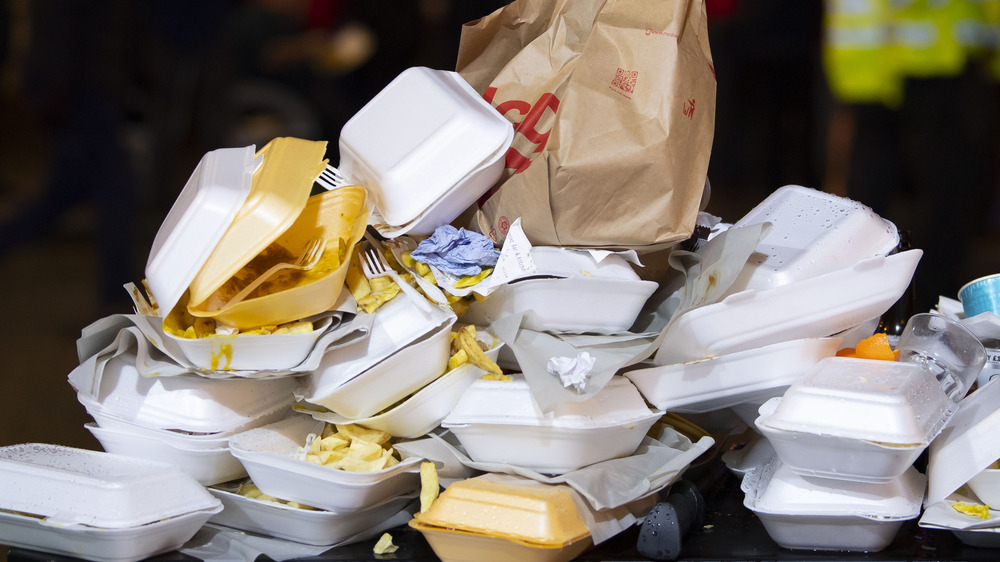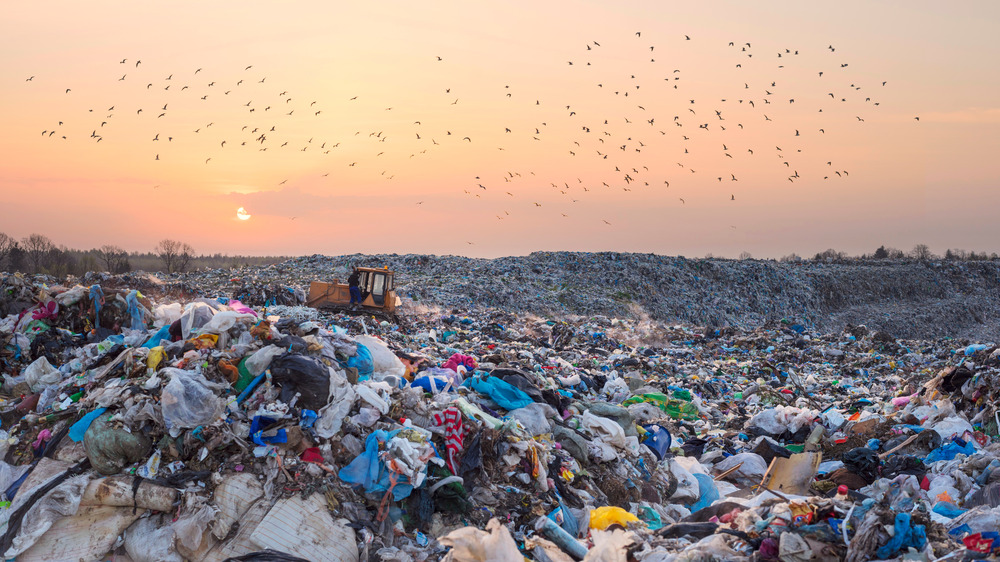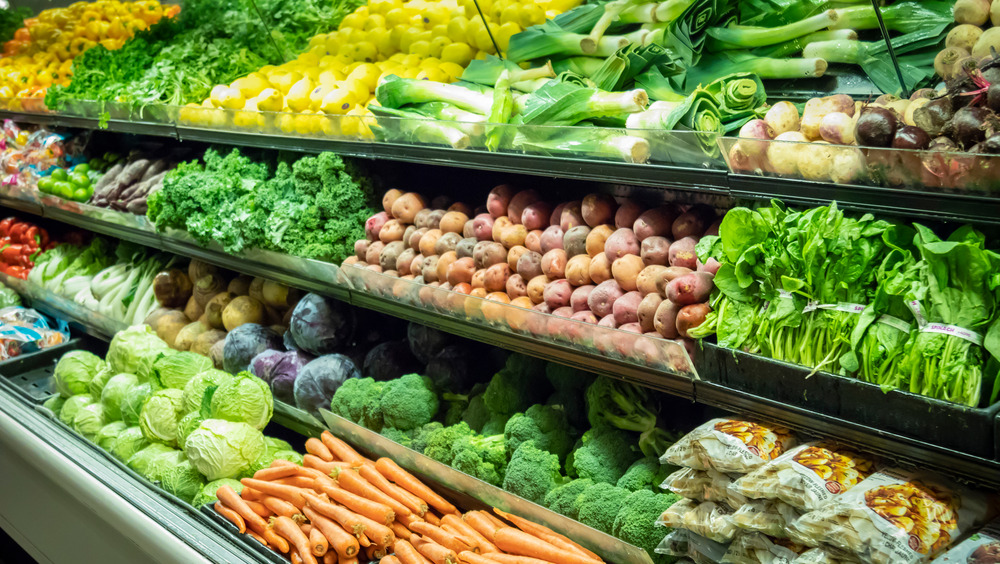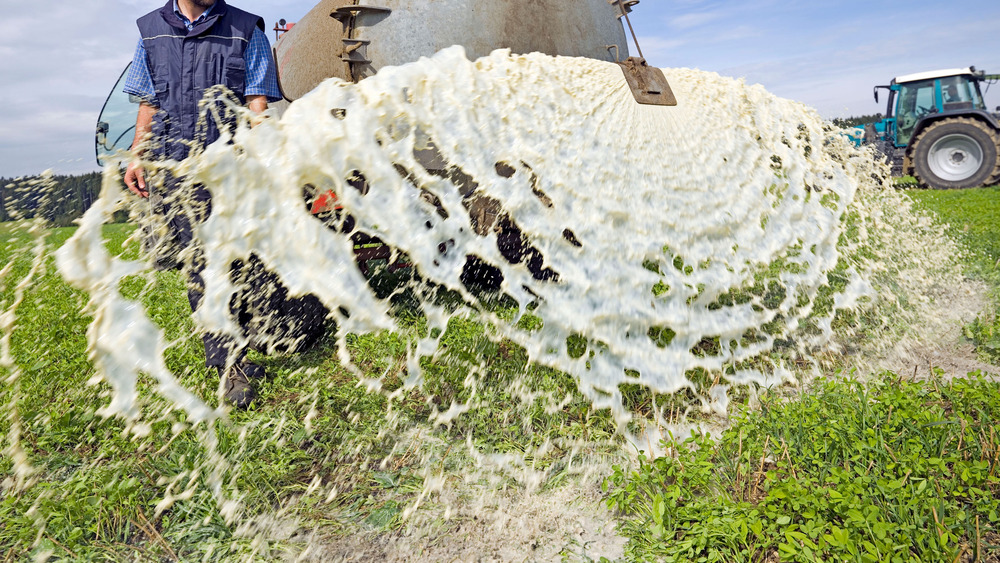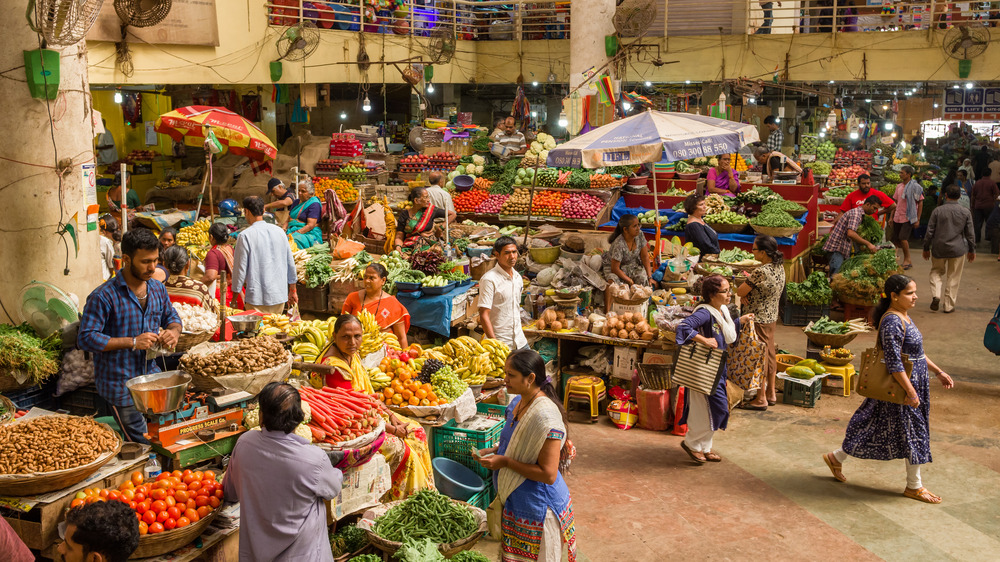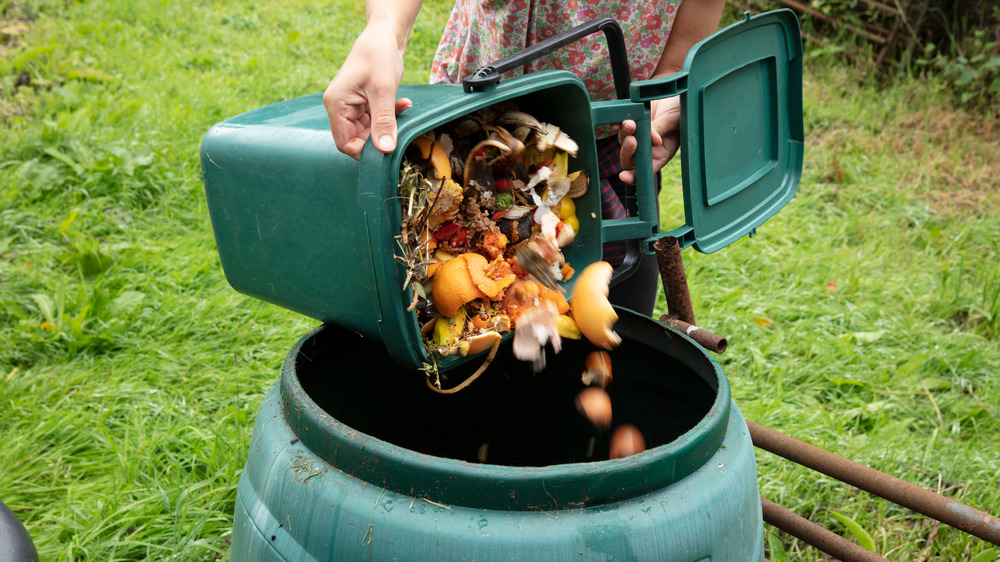This Is How Much Food Gets Wasted In America Every Year
There may be a perception of America as a land of plenty, but a close, honest look at the United States in terms of how we deal with food reveals a nation divided, and with neither side of the divide a cause for celebration. On the one hand, a shocking amount of food gets wasted each and every year, while on the other, millions of Americans live with near daily food insecurity and hunger issues.
The sheer numbers are staggering, and we'll get into the overall tonnage of annual American food waste, the per-person food waste, and so forth soon enough. But what's critical when considering the food waste here and in all nations is the human story behind the numbers. Simply put, there is no excuse for anyone in America to go hungry given how much perfectly viable food is discarded each year.
And beyond that, in terms of economics, a more effective, less wasteful approach to food could help households and businesses save a considerable amount of money each year and in turn, bolster the whole of the economy, with more capital freed up for spending in other areas.
To get an accurate sense of the problem of food waste in America, we combed through resources from government agencies and nonprofits alike, and we reached out to experts in the culinary world for some exclusive insights as well. Read on to find out how food waste in the U.S. is affecting us all.
Food waste in America: The big numbers
According to a report from the U.S. Food and Drug Administration (FDA) titled Food Loss and Waste, between 30 to 40 percent of the entire American food supply ends up wasted each and every year. Yes, you read that correctly: Up to 40% of all food that could have been eaten is wasted. Researchers found that in the year 2010, more than 66 million tons of food were wasted. To be clear, one ton is 2,000 pounds, so we're talking about around 133 billion pounds of wasted food in just one year.
As for economic impact, the report states that the U.S. loses around $161 billion in food every year. In fact, our annual food waste is worth a dollar amount larger than the total gross domestic product (GDP) of more than 130 countries, based on numbers from Worldometer. In other words, the value of the food we through away is worth more than all the goods most countries in the world produce.
The FDA report says that "wasted food is the single largest category of material placed in municipal landfills." This is all the more poignant when you consider the rest of the statement: "[It] represents nourishment that could have helped feed families in need."
How much you could be contributing to American food waste
According to data from the nonprofit FoodPrint, the American consumer might be the worst actor in our food waste problem. In fact, a FoodPrint report titled The Problem of Food Waste states that "households are responsible for the largest portion of all food waste." Yes, you read that correctly: It's not the restaurants we go to, where we see servers take away plates of food waste or spy trashcans full of leftovers, that are the biggest culprits of food waste. Restaurants actually waste about 22 to 33 billion pounds of food per year, while American households waste a whopping 76 billion pounds of food annually.
The report goes deeper into the numbers, calling out each and every American for wasting about 238 pounds of that food every year, and this represents nearly a quarter of all food each consumer purchases (or has purchased for them, at any rate). And the cost? Well, for most of us, it might be about $1800 each.
According to the FoodPrint report, the five main causes of food waste are food spoilage (due to improper storage or "misjudged food needs"), over-preparing (simply making portions too large), date label confusion (foods discarded based on a failed understanding of expiration information), overbuying (needless bulk buys and stocking up), and poor planning.
These are the kinds of foods we waste most often
Palak Patel, Chef at the Institute of Culinary Education, told Mashed that the most commonly wasted types of foods are fresh fruits and vegetables, dairy products, and fresh herbs. The chef, who has appeared on TV shows ranging from Chopped to Food Network Star to Beat Bobby Flay, said of produce: "Vegetables are delicate, have a shorter shelf-life, and often are improperly stored." In regard to dairy, Patel told Mashed that "milk, yogurt, and cheese have a shorter shelf-life and are prone to spoilage."
As for herbs, Chef Patel said that "most recipes call for small amounts of herbs and the rest is often wasted."
While fresh foods are critical for our health, not to mention for use in cooking and serving delicious meals, the volume of perishable food wasted can be dramatically curtailed when consumers consider canned or frozen alternatives — or simply only purchase only what they need.
Ways to reduce household food waste
We asked the Institute of Culinary Education's Chef Palak Patel for some tips on mitigating food waste at the consumer level, and she had a number of ideas.
"Take inventory of foods that you enjoy cooking and eating to simplify shopping," Patel told Mashed. "Have a game plan ready before you get to the grocery store to avoid aimlessly grabbing ingredients which can often lead to good food going to waste."
And don't forget storage: "Storing produce and groceries properly is as important as buying properly," Patel says, and improper storage could mean more wasted food.
"Have a storage system for your food that you implement every time you come home from the grocery store," Patel advises. "It is tempting to throw everything in the fridge in its original packaging, but this is a costly mistake." (Here's some storage tips from Mashed to get you started).
In terms of planning out your shopping, Patel advises consumers "think of four to five meals that help save food that would go to waste" and focus on "versatile meals like pureed dips, fried rice, stir-fry, scrambles, broth and sauces for pasta," since meals like these can make use of ingredients we have lying around. Overall, a good rule of thumb when getting groceries is "to plan at least two different ways to use ingredients."
Patel also advised against buying in bulk if you're worried about food waste: "While it is more cost-efficient at times to buy a larger quantity, it can lead to more food waste."
The pandemic led to an appalling waste of some foods in the U.S.
American dairy farmers dumped out millions of gallons of milk in 2020. Just a few months into the pandemic lockdowns of the spring and already farms across America were discarding so much milk that experts estimated daily dumping totaled some 3.7 million gallons of fresh milk wasted, according to CNN Business. It's difficult to comprehend the scale of loss, but you can try just by thinking about the size and weight of one single gallon of milk and the cows and energy that contributed to it.
Experts say there was really no good way to avoid the dumping, though: With tens of thousands of restaurants shuttered, supply chains disrupted, and consumer behavior altered by COVID-19, there was simply nowhere for the milk to go, and given its perishable nature, there was no good way to store it (via CNN Business). And as farmers can't well ask dairy cows to simply stop producing milk until it's needed, the only options were to cull herds or simply discard the milk.
The good news is that in May of 2020, the US Department of Agriculture (USDA) began planning to purchase the extra milk and repackage it for food banks, CNN Business reports. The USDA hoped this would help farmers with stemming profit loss while supplying food banks. States and some private businesses, like Publix, also joined in the effort.
Food access and hunger are major problems in America
In a country with an annual GDP near $19.5 trillion, it's abhorrent to think that anyone in the U.S. has to worry about feeding their family or themselves, and worse still that many Americans go hungry, but it's also cold, hard fact.
According to Feeding America, more than 35 million people in America experienced hunger in the year 2019. To be clear, that means a hunger that could not be sated, because they could not afford food. And during the 2020 pandemic year, with a glut of Americans suddenly out of work, more than 42 million people in the United States dealt with food insecurity, meaning they were confronted with the very real possibility of hunger — despite food being discarded as a result of lower demand from restaurants and other industries.
Hunger and food insecurity afflict all sorts of Americans: Children, seniors, minority groups, urban and rural residents alike all experience these issues, according to Feeding America. And both cities and rural living situations present challenges to accessing sufficient food at all, with healthy food harder to come by.
According to data compiled by Medical News Today, nearly 25 million Americans live in so-called "food deserts." The article states: "In order to qualify as a food desert... in urban areas, at least 500 people or 33% of the population must live more than 1 mile from the nearest large grocery store. In rural areas, at least 500 people or 33% of the population must live more than 10 miles from the nearest large grocery store."
Food waste on a global scale
If you are shocked and saddened by how much food is wasted each year in America, those sentiments will only deepen when considering food waste as a worldwide issue. According to data from the World Food Program (WFP), people waste enough food each year to feed two billion human beings for an entire year. In terms of dollar amounts, the group's data estimates about one trillion dollars (in United States currency) of annual food loss and waste. (For clarity, food waste refers to food that reached the consumer level, be it at a restaurant or home, and was then discarded uneaten, while food loss can occur when crops are left unharvested, food is damaged or lost in shipping, and for other such causes, but food loss and waste are taken on the whole here.)
Food waste is a global issue with impacts that go beyond the economic and the issue of hunger: It's also an environmental issue. The WFP reports that "if wasted food were a country, it would be the third largest producer of carbon dioxide in the world, after the U.S. and China." So, reducing food waste could not only curtail hunger and save billions of dollars, but could also do wonders for reducing greenhouse gasses in the atmosphere.
One small step you can take to help the problem of food waste
Food waste is a global issue, a national issue, a community issue, and a family and individual issue as well. While individual changes may seem like they have minimal impact on global reality in the short term, if enough consumers can minimize their own food waste problems, the wider issues will be mitigated to some degree.
One small step every household or individual can take immediately is to stop sending spoiled foods or excess from portions to landfills and turning it into nutrient-rich compost instead, whether that's through a compost facility near you or in your own backyard. That compost can in turn be used to grow more food, or to foster the healthy growth of flowers, trees, and shrubs. And, believe it or not, throwing away your old lettuce produces more greenhouse gas than bacon!
When composting at home, it's important to have a proper balance of ingredients in your bin or pile. The most basic way to think about it is balancing so-called browns, like leaves, twigs, or pine needles, with greens, like leftover produce, ground coffee, breads, or fresh lawn cuttings, according to the U.S. Environmental Protection Agency (EPA). In general, you want about a three-to-one ratio of browns to greens (so three times as much volume from, say, dried leaves as from carrot shavings and rotten apples), and you need to keep the contents of your compost bin moist. Once or twice a week, make sure to turn and sift the compost pile to keep the ingredients mixing and breaking down evenly, and plan for at least three months before you start to produce meaningful compost material, with six months being a more likely time frame.
